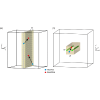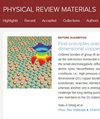热极限镍中严重辐照晶界和位错的结构与迁移
IF 3.4
3区 材料科学
Q2 MATERIALS SCIENCE, MULTIDISCIPLINARY
引用次数: 0
摘要
在高剂量辐照下,材料中预存在晶界(GB)和位错处及其附近的微观结构演变仍然鲜为人知。在这项工作中,我们利用为大块材料高剂量辐照的原子模型而开发的创造弛豫算法(CRA),来探测在辐照下 fcc Ni 中晶界和位错核心区域饱和的热极限。我们发现,在热极限条件下,当单个位错或 GB 不断受到弗伦克尔对的产生作用时,就会出现局部稳态无序缺陷结构,其过剩性质围绕恒定值波动。本研究给出了在辐照下拉长成螺旋状的直螺旋位错和几种低角度和高角度 GB 的案例研究,它们表现出了耦合反应,如外位错吸收、粗化和迁移。在各种类型的 GB 中,发现初始 GB 能量与辐照下的局部稳态 GB 能量之间存在正相关。研究发现,在 CRA 作用下,缺陷核心区域密度相似但初始构型不同的可迁移 GB 结构会趋同于相同的极限结构。比较了原始位错和辐照位错以及 GB 结构在外加剪应力下的机械响应。结果发现,辐照螺钉位错和边缘位错表现出硬化响应,与原始位错相比,它们在更大的流动应力下发生迁移。移动 GB 显示出软化或硬化反应,这取决于 GB 的特性。虽然有些 GB 在迁移到辐射区之外时会恢复其最初的原始结构,但许多 GB 会维持不同的流动应力,这与已改变的移动核心结构相对应。本文章由计算机程序翻译,如有差异,请以英文原文为准。

Structure and migration of heavily irradiated grain boundaries and dislocations in Ni in the athermal limit
The microstructural evolution at and near preexisting grain boundaries (GBs) and dislocations in materials under high radiation doses is still poorly understood. In this work, we use the creation relaxation algorithm (CRA) developed for atomistic modeling of high-dose irradiation in bulk materials to probe the athermal limit of saturation of GB and dislocation core regions under irradiation in fcc Ni. We find that, upon continuously subjecting a single dislocation or GB to Frenkel pair creation in the athermal limit, a local steady-state disordered defect structure is reached with excess properties that fluctuate around constant values. Case studies are given for a straight screw dislocation which elongates into a helix under irradiation and several types of low- and high-angle GBs, which exhibit coupled responses such as absorption of extrinsic dislocations, roughening, and migration. A positive correlation is found between the initial GB energy and the local steady-state GB energy under irradiation across a wide variety of GB types. Metastable GB structures with similar density in the defect core region but different initial configurations are found to converge to the same limiting structure under CRA. The mechanical responses of pristine and irradiated dislocations and GB structures are compared under an applied shear stress. Irradiated screw and edge dislocations are found to exhibit a hardening response, migrating at larger flow stresses than their pristine counterparts. Mobile GBs are found to exhibit softening or hardening responses depending on GB character. Although some GBs recover their initial pristine structures upon migration outside of the radiation zone, many GBs sustain different flow stresses corresponding to altered mobile core structures.
求助全文
通过发布文献求助,成功后即可免费获取论文全文。
去求助
来源期刊

Physical Review Materials
Physics and Astronomy-Physics and Astronomy (miscellaneous)
CiteScore
5.80
自引率
5.90%
发文量
611
期刊介绍:
Physical Review Materials is a new broad-scope international journal for the multidisciplinary community engaged in research on materials. It is intended to fill a gap in the family of existing Physical Review journals that publish materials research. This field has grown rapidly in recent years and is increasingly being carried out in a way that transcends conventional subject boundaries. The journal was created to provide a common publication and reference source to the expanding community of physicists, materials scientists, chemists, engineers, and researchers in related disciplines that carry out high-quality original research in materials. It will share the same commitment to the high quality expected of all APS publications.
 求助内容:
求助内容: 应助结果提醒方式:
应助结果提醒方式:


